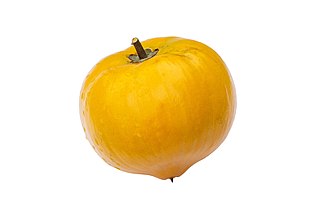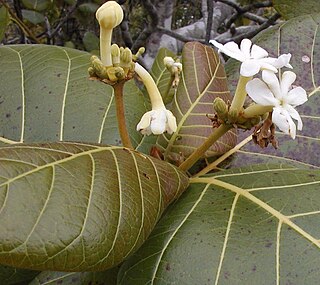
Plumeria, also known as frangipani, is a genus of flowering plants in the subfamily Rauvolfioideae, of the family Apocynaceae. Most species are deciduous shrubs or small trees. The species are native to the Neotropical realm, but are often grown as cosmopolitan ornamentals in tropical regions, especially in Hawaii, as well as hot desert climates in the Arabian Peninsula with proper irrigation.

Sapote is a term for a soft, edible fruit. The word is incorporated into the common names of several unrelated fruit-bearing plants native to Mexico, Central America and northern parts of South America. It is also known in Caribbean English as soapapple.

Pouteria campechiana is an evergreen tree native to, and cultivated in, southern Mexico, Belize, Guatemala, and El Salvador. It is cultivated in other countries, such as India, Costa Rica, Brazil, the United States, the Dominican Republic, Australia, Cambodia, Vietnam, Indonesia, Sri Lanka, Nigeria, and the Philippines. The edible part of the tree is its fruit, which is colloquially known as an egg fruit.

Chaetocarpus is a plant genus of the family Peraceae, formerly Euphorbiaceae, first described as a genus in 1854. Chaetocarpus species are trees or shrubs. They are native to the Americas, Africa, and Asia. Some species are endangered.
- Chaetocarpus acutifolius(Britton & P.Wilson) Borhidi – Sierra de Moa in Cuba
- Chaetocarpus africanusPax – C Africa
- Chaetocarpus castanocarpus(Roxb.) Thwaites – SE Asia, Yunnan, Assam, Bangladesh, Sri Lanka
- Chaetocarpus cordifolius(Urb.) Borhidi – Cuba, Hispaniola, Jamaica
- Chaetocarpus coriaceusThwaites – Sri Lanka
- Chaetocarpus cubensisFawc. & Rendle – Cuba
- Chaetocarpus echinocarpus (Baill.) Ducke – Bolivia, Brazil
- Chaetocarpus ferrugineusPhilcox – Sri Lanka
- Chaetocarpus gabonensisBreteler – Gabon
- Chaetocarpus globosus(Sw.) Fawc. & Rendle – Jamaica, Cuba, Dominican Rep.
- Chaetocarpus myrsinitesBaill. – Bolivia, Brazil
- Chaetocarpus parvifoliusBorhidi – Cuba
- Chaetocarpus pearceiRusby – Bolivia
- Chaetocarpus pubescens(Thwaites) Hook.f. – Sri Lanka
- Chaetocarpus rabarabaCapuron – Madagascar
- Chaetocarpus schomburgkianus(Kuntze) Pax & K.Hoffm. – Colombia, Venezuela, 3 Guianas, NW Brazil
Grimmeodendron is a plant genus of the family Euphorbiaceae first described as a genus in 1908. It is native to the West Indies.
- Grimmeodendron eglandulosum(A.Rich.) Urb. - Bahamas, Cuba, Hispaniola
- Grimmeodendron jamaicenseUrb. - Jamaica

Pouteria is a genus of flowering trees in the gutta-percha family, Sapotaceae. The genus is widespread throughout the tropical Americas, with outlier species in Cameroon and Malesia. It includes the canistel, the mamey sapote, and the lucuma. Commonly, this genus is known as pouteria trees, or in some cases, eggfruits.

Pouteria sapota, the mamey sapote, is a species of tree native to Mexico and Central America. The tree is also cultivated in the Caribbean. Its fruit is eaten in many Latin American countries. The fruit is made into foods such as milkshakes and ice cream.

Sideroxylon is a genus of trees in the family Sapotaceae described as a genus by Linnaeus in 1753. They are collectively known as bully trees. The generic name is derived from the Greek words σιδηρος (sideros), meaning "iron", and ξύλον (xylon), meaning "wood."
Bactris jamaicana is a spiny palm which grows in multi-stemmed clumps. It is endemic to Jamaica.

Erik Leonard Ekman was a Swedish botanist and explorer.

Bourreria succulenta is a species of flowering plant in the family Boraginaceae. It is a tree native to Caribbean islands including Cuba, Hispaniola, Jamaica, Puerto Rico, and the Lesser Antilles, and to Florida, southern Mexico, and northern Venezuela. It is known by several synonyms, including Bourreria baccata and B. velutina. Common names include cherry, currant tree, poisonberry, chink, and bodywood.

Casasia is a genus of flowering plants in the family Rubiaceae. These shrubs or small trees occur on the Caribbean islands and in one case in Florida. Some of the ten accepted species were formerly placed elsewhere, e.g. in the related genip-tree genus (Genipa), in Gardenia or in Randia.

Guettarda is a plant genus in the family Rubiaceae. Most of these plants are known by the common name velvetseed.
Rochefortia cuneata is a species of plant in the family Boraginaceae. It is shrub native to the Bahamas, Cuba, Hispaniola, and Jamaica.

Leucothrinax morrisii, the Key thatch palm, is a small palm which is native to the Greater Antilles, northern Lesser Antilles, The Bahamas and Florida and the Florida Keys in the United States.
Anastraphia is a genus of flowering plants in the family Asteraceae. It includes 33 species native to the Caribbean, including Cuba, Hispaniola, the Bahamas, and the Turks and Caicos Islands.
Calliandra haematomma is a species of flowering plants of the genus Calliandra in the family Fabaceae. Calliandra pilosa is a synonym of C. haematomma var. glabrata.
Pseudocarpidium is a genus of flowering plants in the family Lamiaceae first described in 1906. It is native the West Indies.
- Pseudocarpidium avicennioides(A.Rich.) Millsp. - eastern Cuba
- Pseudocarpidium domingense(Urb. & Ekman) Moldenke - Hispaniola
- Pseudocarpidium ilicifolium (A.Rich.) Millsp. - Cuba
- Pseudocarpidium multidens(Urb.) Moldenke - eastern Cuba
- Pseudocarpidium neglectaBisse - Cuba
- Pseudocarpidium pungensBritton - eastern Cuba
- Pseudocarpidium rigens(Griseb.) Britton - eastern Cuba
- Pseudocarpidium shaferiBritton - eastern Cuba
- Pseudocarpidium wrightiiMillsp. - Bahamas, Cuba
Colleteria is a genus of flowering plants in the family Rubiaceae, native to Cuba, Hispaniola, and Puerto Rico. Among other differences from the genus Chione, from which they were split, they have fruit with two pyrenes.












